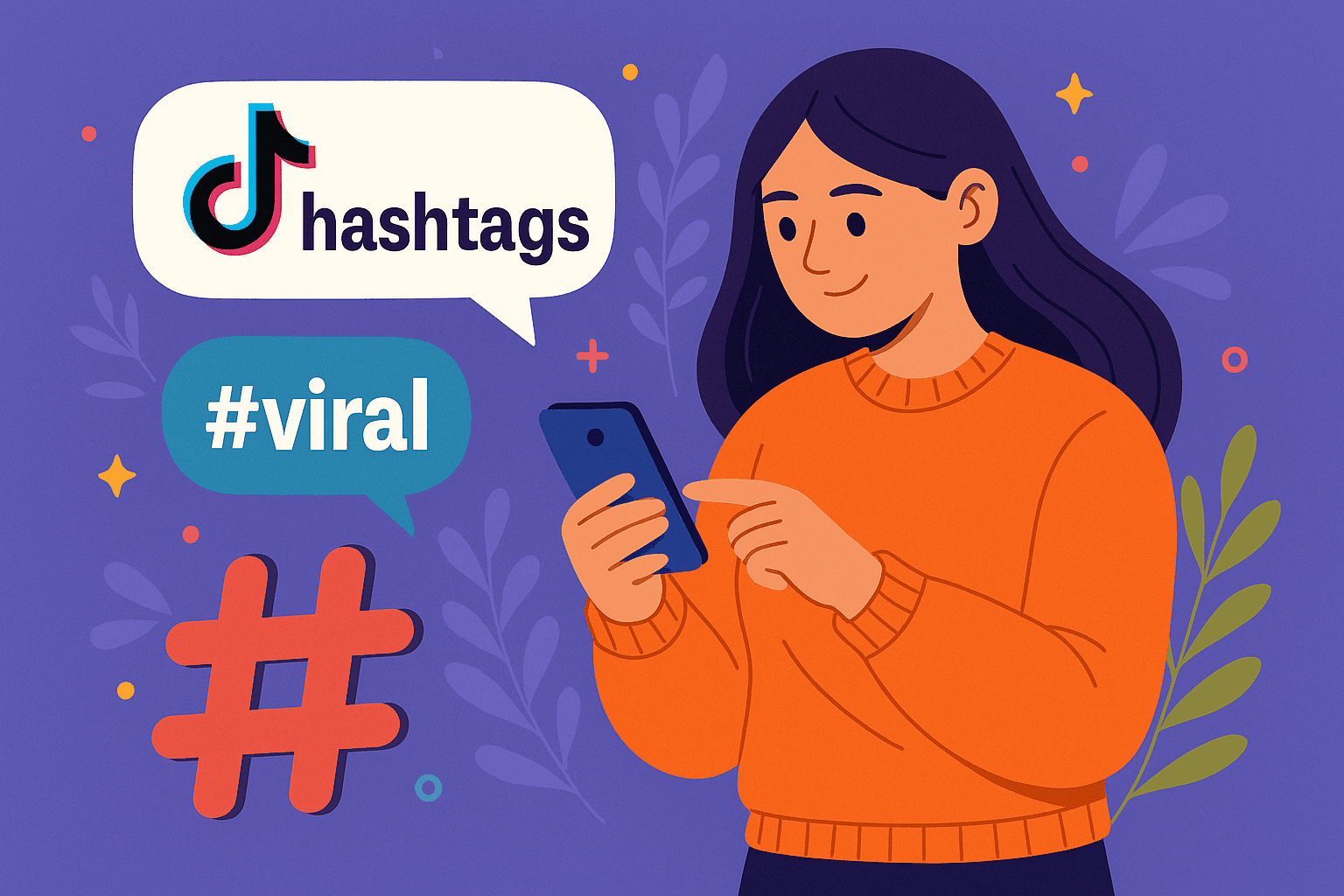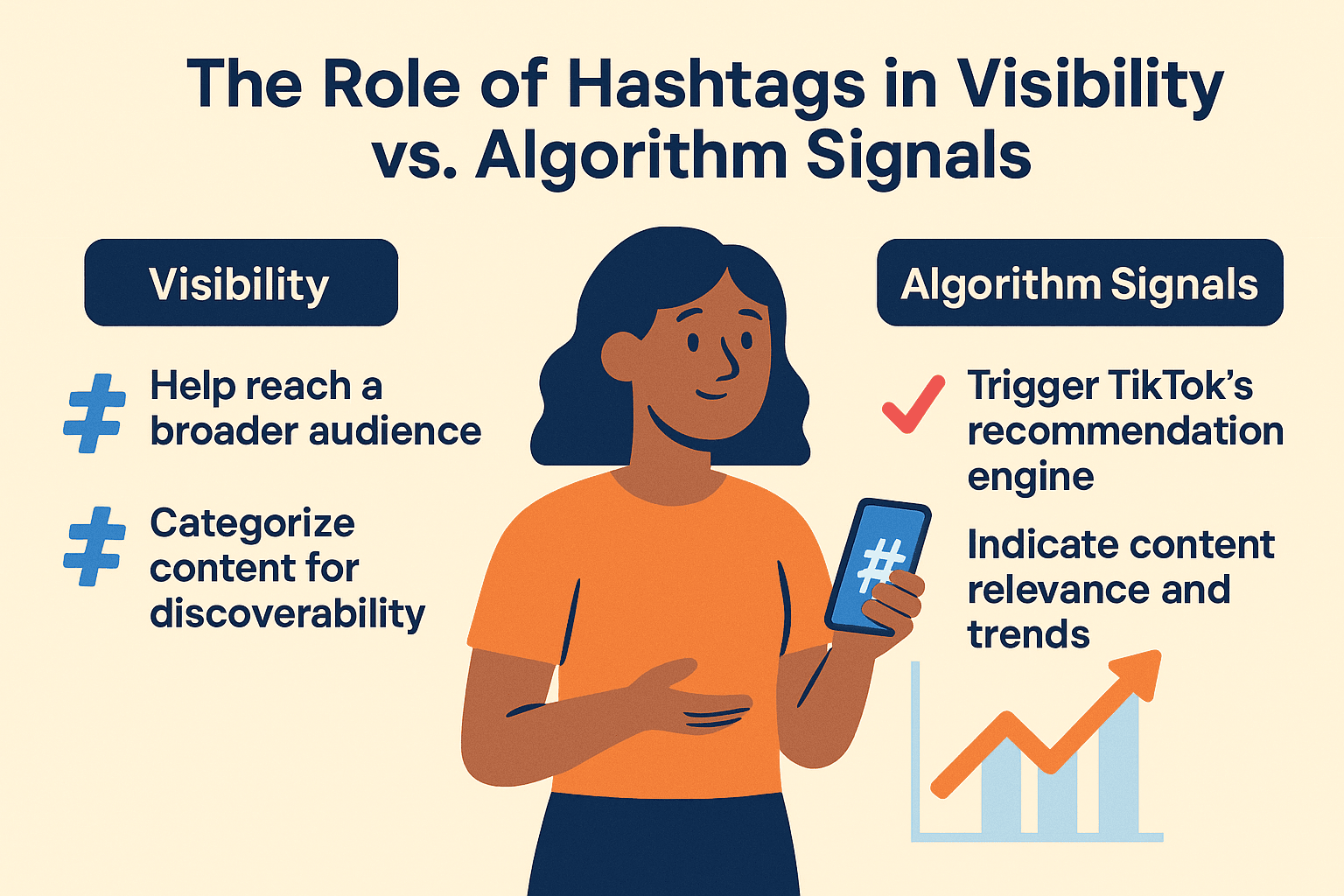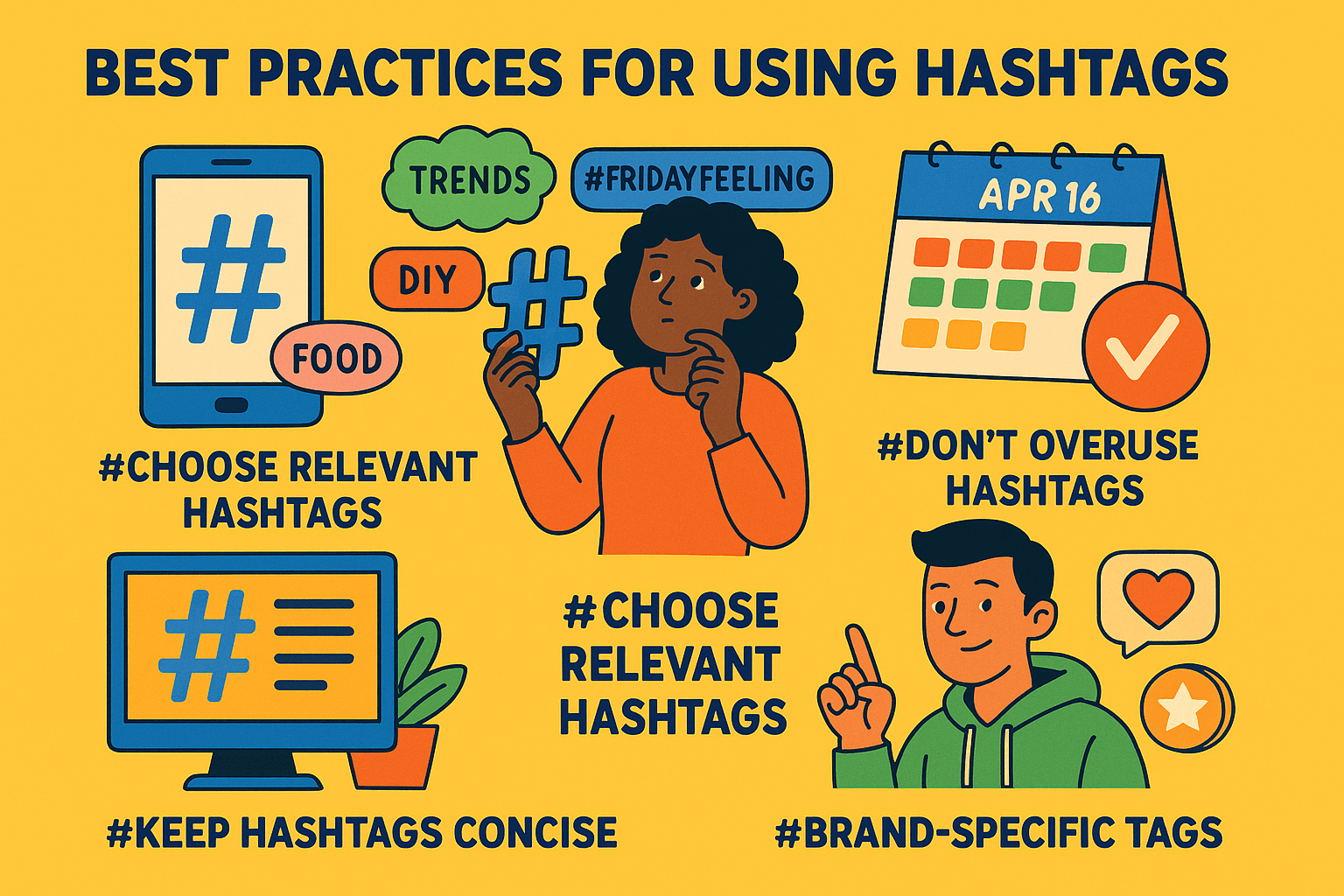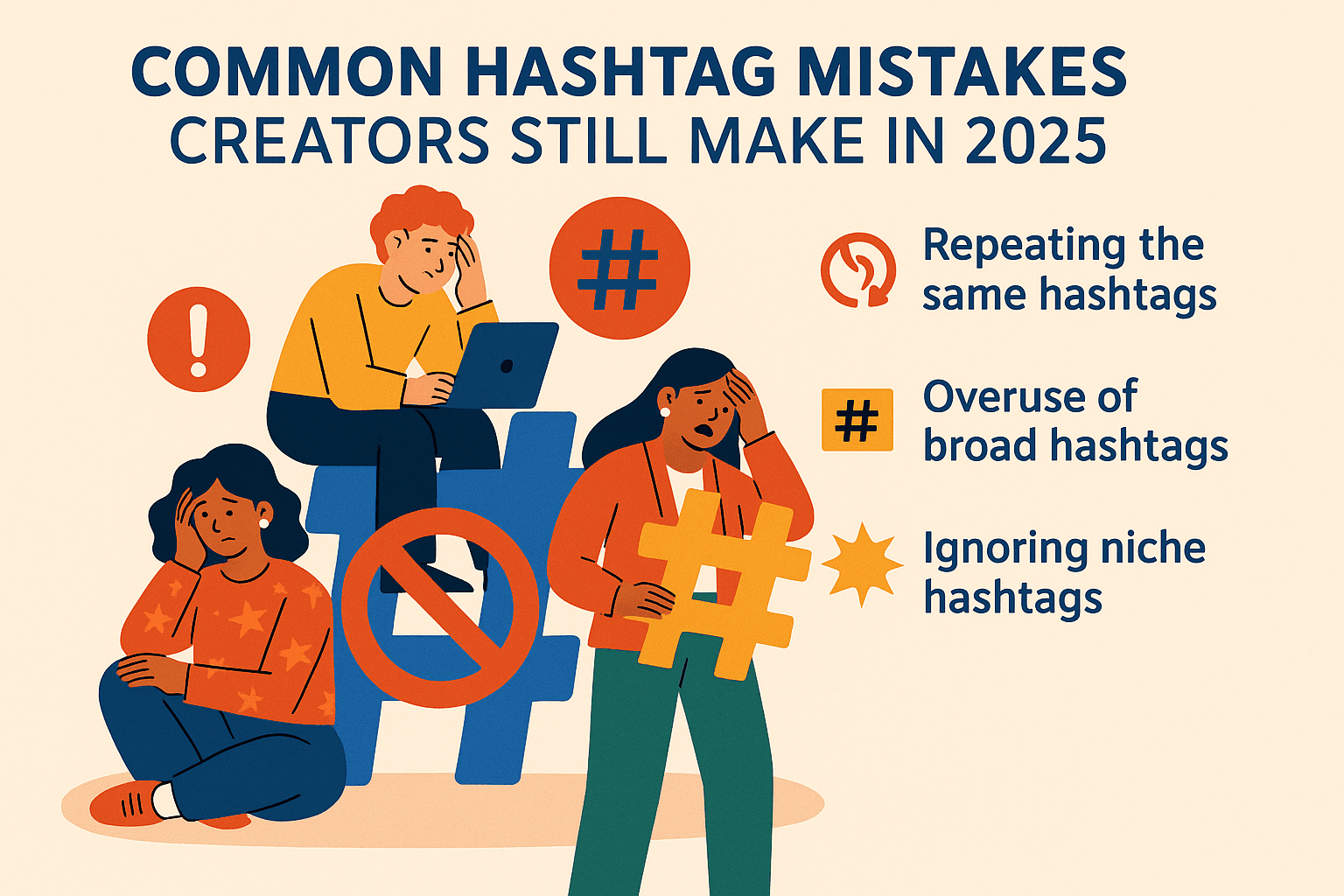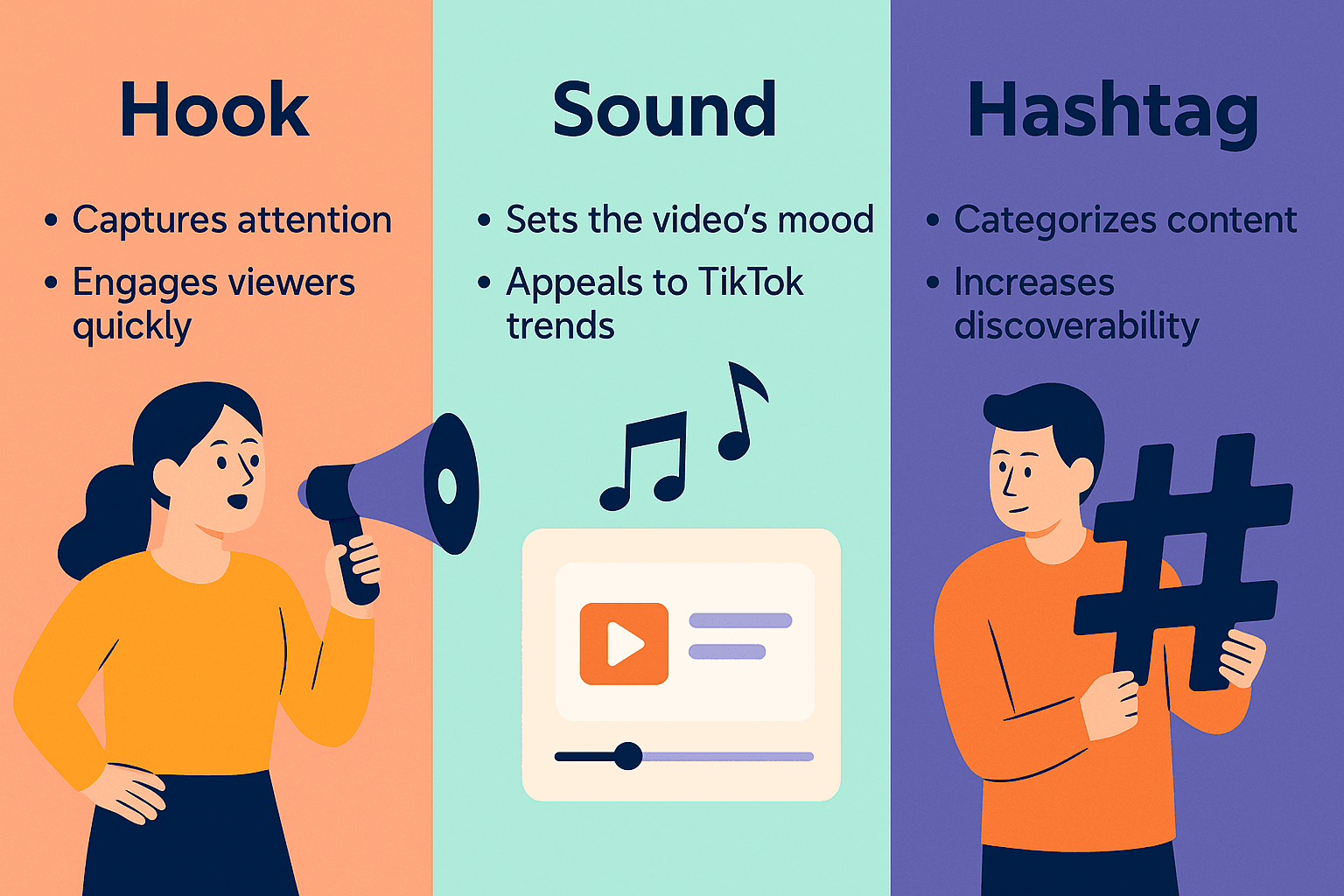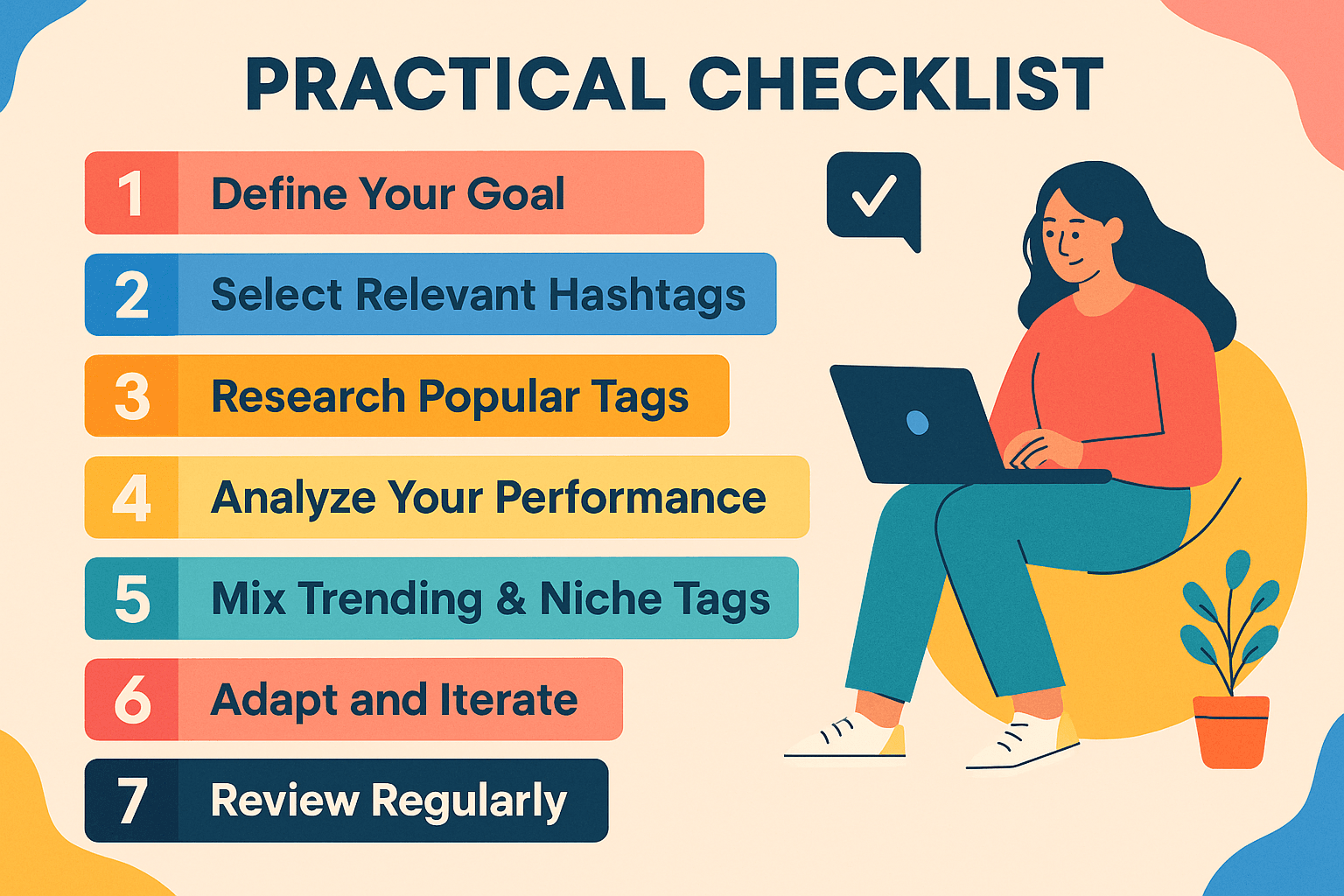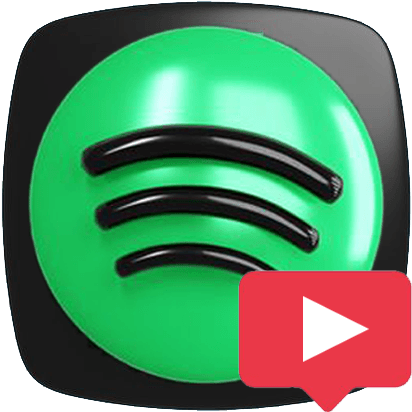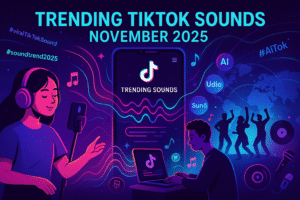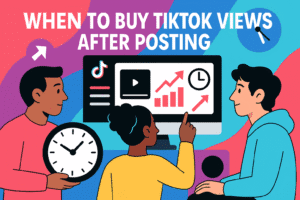How TikTok’s Algorithm Views Hashtags in 2025
TikTok’s algorithm in 2025 is no longer the simple “hashtags = visibility” formula that worked in 2019–2021. Today, the algorithm is a multi-layered recommendation system that prioritizes behavioral signals like:
- Watch time — how long viewers stay on your video.
- Engagement quality — not just likes, but meaningful actions like comments, shares, and profile clicks.
- Video structure — strong hooks, pacing, and editing style.
- Audience match — whether your content fits with a user’s past interactions.
So where do hashtags fit in?
Content Categorization
Hashtags still act as labels. They help TikTok understand your video’s topic, niche, or trend association. For example, using#FitnessTipsor#MealPrep2025signals which audience segment might enjoy your content.Trend Discovery
TikTok pushes trending hashtags to keep users engaged. When you attach a trending or viral hashtag, the algorithm can connect your video with others in the same conversation.Search Visibility
With TikTok’s search bar and AI-powered indexing, hashtags influence whether your video shows up when people search “best TikTok hashtags 2025” or “funny cat TikTok.”Risk Factor
Misused or banned hashtags (like those tied to spam or unsafe content) now have the opposite effect — they can limit reach or even trigger a shadowban.
In short: TikTok hashtags are no longer the main growth engine, but they still guide the algorithm on how to categorize and distribute your content. The key in 2025 is to use hashtags strategically as signals, not as a replacement for strong content.
The Role of Hashtags in Visibility vs Algorithm Signals
The TikTok of 2025 is not the same as it was just a few years ago. Back then, creators could copy-paste a block of 20 popular hashtags and see views climb almost overnight. Today, the platform is much smarter. The algorithm’s behavioral signals often outweigh hashtags — but that doesn’t mean hashtags are useless. They’ve simply shifted from being the engine of growth to being supporting indicators.
When Hashtags Still Boost Visibility
Niche Discovery
Using hashtags like
#BookTok2025,#FitnessForMoms, or#CryptoTokconnects you with hyper-specific audiences.TikTok groups niche content together, so hashtags still act like “topic labels.”
Search Intent & SEO on TikTok
TikTok now functions as a search engine — many Gen Z users search TikTok before Google.
If your video is tagged with
#BestTikTokHashtags2025, it has a higher chance of appearing when users type that exact phrase.
Trend Alignment
Viral hashtags (e.g.,
#TikTokMadeMeBuyIt,#StoryTime2025) place your video into an ongoing trend pool.The algorithm surfaces new videos under trending tags to keep conversations fresh.
Community Credibility
Some hashtags act as credibility signals. For example, if you’re posting marketing tips, being active under
#MarketingTokor#SideHustleTipsshows you belong to that niche.
When the Algorithm Outshines Hashtags
Strong Content Hook
A 3–5 second hook that makes people stop scrolling weighs more than any hashtag.
Example: A video that grabs attention in the first second can outperform another with 20 trending hashtags but a weak intro.
Engagement Loops
TikTok now measures saves, shares, comments, and replays more heavily than tags.
If users engage deeply, your content will spread even if you used no hashtags at all.
Personalized Feed Matching
TikTok’s algorithm has enough behavioral data to recommend your video directly to the right people.
In many cases, TikTok can figure out your video topic based on captions, audio, and engagement — even without hashtags.
Hashtag Overuse = Negative Signal
Dumping irrelevant or generic hashtags (
#fyp,#viral,#love) is seen as spammy.TikTok now reduces reach if hashtags look forced or mismatched with the content.
Hashtags vs Algorithm Signals in 2025
- Hashtags = Discovery & Categorization
- Algorithm = Distribution & Visibility
Think of hashtags as a map that tells TikTok where your video belongs. But the algorithm decides how far it travels and how many people see it.
Key Takeaway
In 2025, hashtags alone won’t make you viral. But when paired with engaging content and strong algorithm signals, they amplify your reach and ensure your videos are indexed, searchable, and connected to the right communities. The winning strategy is to balance both: use hashtags smartly to guide the algorithm, but rely on your content quality to carry the video.
Types of Hashtags to Use in 2025 (Branded, Niche, Trending)
Hashtags on TikTok aren’t “one size fits all.” Using the wrong kind (like stuffing 10 generic hashtags) can actually hurt your reach. The best results in 2025 come from blending three main types of hashtags — each playing a different role in growth.
Branded Hashtags — Build Recognition & Ownership
Branded hashtags are custom tags tied to your name, campaign, or community.
Examples:
- For SMMNut:
#SMMNutTips,#GrowWithSMMNut - For Nike:
#JustDoIt - For influencers:
#[CreatorName]Challenge
Why they matter:
- Brand Recall: Makes it easier for people to remember your content.
- Community Building: Fans can use your hashtag to join the conversation.
- Content Tracking: Lets you track how much UGC (user-generated content) is made under your brand.
Pro Tip: Launch challenges or campaigns using your branded hashtag. Even if the reach is smaller than viral tags, it builds long-term identity and loyal followers.
Niche Hashtags — Target Specific Communities
Niche hashtags place you inside TikTok’s subcultures, where the algorithm is already clustering people with shared interests.
Examples:
- Beauty:
#MakeupTok,#SkincareRoutine2025 - Fitness:
#GymTok,#YogaJourney - Food:
#RecipeTok,#StreetFood2025 - Entrepreneurs:
#SideHustleTok,#MarketingTips2025
Why they matter:
- Hyper-Targeted Reach: You attract people who care about your niche, not random browsers.
- Community Credibility: Being active under
#BookTokor#CryptoTokshows you’re part of the culture. - Algorithm Boost: TikTok uses niche hashtags as labels to group your video with others in the same category, increasing the chance it reaches the right FYP.
Pro Tip: Mix 2–3 niche hashtags per video to “slot” your content into multiple communities. This is especially powerful for small creators looking to find their first loyal audience.
Trending Hashtags — Ride the Wave of Virality
Trending hashtags are TikTok’s adrenaline shot: they spike your reach fast but usually fade quickly.
Examples (2025):
- Viral Commerce:
#TikTokMadeMeBuyIt - Storytelling:
#StoryTime2025 - Challenges:
#FlipTheSwitch2025,#GlowUpChallenge
- Viral Commerce:
Why they matter:
- Instant Exposure: Trending hashtags are actively promoted by TikTok.
- Cultural Relevance: They tap into what everyone is talking about right now.
- Testing Ground: Great for experimenting with different formats and seeing what resonates.
But be careful:
- Overusing trending hashtags without context can make your video look spammy.
- Some viral hashtags later become restricted (shadowban risk). Always check safe lists before posting.
Pro Tip: Use 1 trending hashtag per video, but pair it with your niche + branded hashtags for balance.
Best Practice in 2025: The Hashtag Stack
Instead of dumping 10–20 hashtags, think of your captions as a stack that layers brand, niche, and trending categories.
The Formula:
- 1–2 Branded Hashtags → Long-term recognition
- 2–3 Niche Hashtags → Community targeting
- 1–2 Trending Hashtags → Short-term visibility boost
Example for a Fitness Creator:#MyFitnessJourney #WorkoutTips #GymTok #HomeWorkout2025 #GlowUpChallenge
This stack makes your content:
- Belong to your personal brand
- Reach the fitness community
- Tap into a current viral wave
Key Takeaway
Hashtags are signals, not magic tricks. In 2025, the creators who win are those who strategically combine branded, niche, and trending hashtags instead of spamming generic ones. Balance is everything: branded hashtags give you identity, niche hashtags give you relevance, and trending hashtags give you visibility.
How Many Hashtags Are Enough in 2025?
One of the most common mistakes on TikTok is overloading captions with hashtags. In 2019, it wasn’t unusual to see videos with 15–20 tags like #fyp #viral #love #funny #trending. That doesn’t work anymore.
TikTok in 2025 is smarter, and stuffing hashtags can actually hurt your visibility. Instead, success comes from choosing a balanced number of hashtags that complement the algorithm.
What TikTok Recommends vs What Actually Works
- Officially: TikTok suggests 3–5 hashtags per video to maximize discoverability.
- In Practice: Most successful creators use 4–7 carefully chosen hashtags, blending branded, niche, and trending.
- The Risk Zone: Anything above 10 hashtags often looks spammy and reduces trust — both from TikTok’s algorithm and viewers.
Smart Hashtag Usage in 2025
Keep it Relevant
Every hashtag should describe your content, your audience, or your brand.Good:
#HomeWorkout2025 #FitnessTips #GymTokBad:
#Love #FYP #Smile #Cute(generic + irrelevant).
Mix Types Wisely
1–2 Branded hashtags → For recognition.
2–3 Niche hashtags → To target the right community.
1–2 Trending hashtags → For short-term exposure.
Place Them Naturally
Add hashtags at the end of your caption, not crammed awkwardly into sentences.
Example caption:
“Tried this 15-minute home workout routine and the results surprised me 💪 #HomeWorkout2025 #FitnessTips #GymTok #GlowUpChallenge”
Why Too Many Hashtags Backfire
- Looks Spammy: Users scroll past videos that look desperate for reach.
- Confuses the Algorithm: TikTok can’t clearly categorize your content if you include hashtags from multiple unrelated niches.
- Lower Engagement: Cluttered captions distract from the message and reduce watch time.
In 2025, the sweet spot is 4–7 hashtags per video. Enough to give TikTok the signals it needs, but not so many that you look spammy. Think of hashtags as seasoning — the right amount enhances the dish, but too much ruins it.
Common Hashtag Mistakes Creators Still Make in 2025
Even though TikTok has evolved, many creators still treat hashtags the same way they did years ago. These mistakes not only limit reach but can actively harm your account’s growth. Here are the most common pitfalls to avoid in 2025:
❌ Overloading Captions with Hashtags
- Adding 15–20 hashtags makes your video look spammy.
- TikTok’s algorithm may even suppress videos with excessive or irrelevant tags.
- Better Approach: Stick to 4–7 carefully chosen hashtags that directly match your content and audience.
❌ Using Generic Tags Like #FYP or #Viral
- Millions of videos use
#fyp,#viral, or#love. - These don’t give TikTok useful context about your video.
- Better Approach: Use hashtags that describe your niche, trend, or brand. Example: Instead of
#fyp, try#FitnessForBeginnersor#MarketingTips2025.
❌ Copy-Pasting the Same Set Every Time
- Using the exact same hashtag block for every video looks lazy and robotic.
- The algorithm picks up on repetition and may reduce your reach.
- Better Approach: Rotate your hashtag sets. Have 2–3 variations for different content types (e.g., workouts, challenges, behind-the-scenes).
❌ Ignoring Banned or Restricted Hashtags
- Some hashtags trend briefly but are later restricted (e.g., for sensitive topics, spam, or policy violations).
- Using them can trigger a shadowban or drastically reduce visibility.
- Better Approach: Always check TikTok’s banned/restricted list and stay updated through creator forums.
❌ Mixing Unrelated Niches in One Post
- Example: Posting a workout video with hashtags like
#CookingTok #PetTok #FashionTips. - This confuses TikTok’s recommendation engine.
- Better Approach: Stay consistent. Each video should focus on one main niche.
❌ Forgetting About Branded Hashtags
- Many creators skip branded hashtags, missing an easy chance to build recognition.
- Better Approach: Always include at least one branded hashtag tied to your identity or campaign (e.g.,
#SMMNutTips).
❌ Thinking Hashtags Alone Will Make You Viral
- Hashtags can’t save poor content. If the video doesn’t grab attention in the first 3 seconds, hashtags won’t fix it.
- Better Approach: Treat hashtags as supporting signals, not the foundation of growth.
In 2025, the creators who win aren’t the ones with the longest hashtag lists — they’re the ones who use fewer, smarter, and safer hashtags. Avoiding these mistakes keeps your videos categorized correctly, helps you stay safe from shadowbans, and builds a trustworthy profile.
Hashtags vs Sounds vs Hooks in 2025
What Matters More?
For years, TikTok creators have debated: what drives growth more — hashtags, sounds, or hooks? In 2025, the answer is clear: hooks get the algorithm’s attention, sounds fuel virality, and hashtags provide structure.
Why Hooks Are Now the #1 Growth Factor
First-Second Impact
- TikTok decides in the first few seconds whether your video deserves to be pushed further.
- A strong hook (“Wait until you see this…” / “I bet you didn’t know…”) grabs attention and signals value.
Watch Time Booster
- If viewers stay past the first 3–5 seconds, TikTok rewards your video with more impressions.
- This makes hooks the most reliable growth lever in 2025.
Works Without Trends
- Even if you don’t use trending sounds or hashtags, a good hook alone can carry your video.
Why Sounds Matter More
TikTok’s DNA Is Music & Audio
- The platform was built on sound discovery (remember Musical.ly?).
- Viral songs, voiceovers, and sound clips drive most trends, from dances to memes.
Algorithm Prioritization
- TikTok heavily promotes videos that use trending sounds.
- When a sound goes viral, TikTok creates a dedicated page for it, featuring videos using that clip — a built-in discovery engine.
User Behavior
- Many users search or browse content by sound.
- If your video is tied to a viral sound, it has a higher chance of being seen by curious scrollers exploring that audio trend.
Why Hashtags Still Matter
Content Categorization
- Hashtags give TikTok context: what niche your video belongs to and who should see it.
- Example:
#FitnessTips2025tells the algorithm you want to reach health-conscious users.
Trend Tracking
- Just like sounds, viral hashtags group trending videos together.
- Example:
#TikTokMadeMeBuyItor#StoryTime2025.
Search Optimization
- Hashtags improve your chances of being found through TikTok’s search bar, especially for informational or niche queries.
Best Practice for 2025
- Start with the Hook: Grab attention in the first 3 seconds — this is your ticket to higher retention.
- Layer a Trending Sound: If it matches your niche, add a viral audio clip for extra discoverability.
- Add Relevant Hashtags: Guide TikTok’s categorization so the video reaches the right audience.
Example:
A fitness creator could open with a hook — “Most people do pushups wrong — here’s how to fix it” — then pair it with a trending audio and niche hashtags like #HomeWorkout2025 #FitnessTips.
This way, the video wins on all three fronts: hook = retention, sound = virality, hashtags = niche targeting.
Building a Hashtag Strategy in 2025
By now, you know hashtags aren’t magic — they’re supporting signals. The secret is to use them intentionally as part of your broader TikTok growth plan. Here’s a simple, actionable checklist you can apply to every video in 2025:
Step 1: Define Your Content Goal
- Is your video meant to build brand awareness, drive engagement, or go viral quickly?
- Your hashtag mix should reflect your goal:
- Awareness → More branded hashtags.
- Engagement → Niche hashtags that connect with communities.
- Virality → Trending hashtags paired with sounds.
Step 2: Pick 1–2 Branded Hashtags
- Always include at least one branded tag (e.g.,
#SMMNutTips). - Helps build recognition over time.
Step 3: Add 2–3 Niche Hashtags
- Choose hashtags specific to your audience.
- Examples:
#CryptoTok,#BeautyTok,#FitnessForBeginners. - These ensure TikTok categorizes your video correctly.
Step 4: Test 1–2 Trending Hashtags
- Browse TikTok’s “Trending” tab daily.
- Add only if relevant — don’t force it.
- Example: A business tip video could pair with
#StoryTime2025if told in a narrative format.
Step 5: Keep Total Count Between 4–7
- Avoid spamming with 10+ hashtags.
- TikTok prioritizes clarity over volume in 2025.
Step 6: Rotate Hashtag Sets
- Don’t copy-paste the same block every time.
- Prepare 2–3 variations for your niche and rotate them.
Step 7: Review Performance Monthly
- Check analytics to see which hashtags delivered the most reach.
- Double down on high performers, retire underperformers.
- Stay updated on banned/restricted hashtags.
- Quick Example (Fitness Video Caption in 2025)
“Most people do pushups wrong — here’s the fix #HomeWorkout2025 #FitnessTips #GymTok #GlowUpChallenge”
Branded? No, but niche + trending hashtags are in balance. For brand accounts, swap one for your branded tag.
In 2025, building a hashtag strategy isn’t about how many hashtags you use — it’s about choosing the right mix. Pair branded, niche, and trending hashtags, keep them relevant, and review performance regularly. Over time, this builds authority and trust while avoiding spam signals.
Explore More on TikTok Hashtags
Mastering hashtags is just one piece of the TikTok growth puzzle. To go deeper, check out these related guides:
- Best TikTok Hashtags to Use in 2025 → Updated lists of safe, high-performing hashtags for different niches.
- TikTok Banned Hashtags 2025 → Avoid shadowbans with the latest restricted hashtag list.
- Niche TikTok Hashtags 2025 → Find the perfect tags for beauty, fitness, food, and more.
- TikTok Hashtags vs Algorithm: What Matters More? → Compare hashtags with TikTok’s powerful recommendation system.
- Trending TikTok Hashtags in 2025 → See which hashtags are going viral this year.
Do TikTok Hashtags Still Matter in 2025?
Hashtags aren’t dead — but they’re not the magic trick they once were either. In 2025, TikTok hashtags act as signals that guide the algorithm, not as the main growth driver.
- Hooks capture attention.
- Sounds fuel virality.
- Hashtags provide structure, categorization, and discoverability.
The best strategy is to use hashtags intentionally:
- 1–2 branded hashtags to build identity.
- 2–3 niche hashtags to reach the right audience.
- 1–2 trending hashtags to ride cultural waves.
When paired with strong content, hashtags can still give you the edge you need to stand out and stay searchable on TikTok in 2025.

